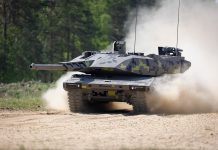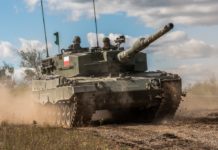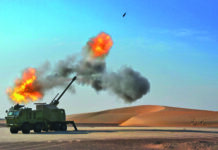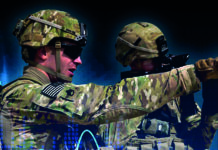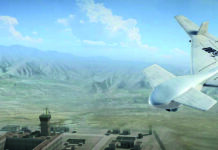The tempo and lethality of war is accelerating. Smarter, more precise weapons, which are linked to ubiquitous sensors, have created a very deadly battlespace. The recent Azerbaijan-Armenian war, where Armenian tank forces were decimated by Azerbaijani drones, sensors, long-range artillery and precision missile strikes, demonstrated this point. It also exposed the weakness of traditional thinking concerning how to fight modern wars.
With the dramatic success of precision unmanned aerial weapons against armoured vehicles in this war, many question the role of the Main Battle Tank (MBT). Tanks still play a critical role in war, but they must become more agile to survive and win in this new, more lethal battlespace. Nearly every MBT in the world today was developed during the Cold War and as they are upgraded with additional armour, larger calibre cannons and active & passive protection systems, they are getting heavier and agility is suffering. The agility of a tank is its ability to speed up, turn, jink, and stop. To move heavier MBTs, powerful engines that generate tremendous horsepower are required.
You also need a reliable transmission that can reduce and vary the higher engine speed to the slower speed of the tank track. Thus, the engine and the transmission are the critical components of agility. In his book “Tank Warfare”, the great tank expert Richard Simpkin stated that the most important factor in tank agility is the tank’s power-weight ratio, the horsepower (hp) available per ton of tank weight. This article reviews the engines of the Russian T-90M and the Republic of Korea’s K2 BLACK PANTHER to describe the current state of the technology and briefly assess the emerging Franco-German Main Ground Combat System (MGCS) concept.
The T-90M
The T-90M PRORYV-3 (BREAKTHROUGH) tank is a state-of-the-art, third generation MBT and provides the Russian Army with a powerful and survivable tank with better protection, firepower and increased mobility than other tanks in the Russian inventory. This is the most important tank in the Russian arsenal, as it merges the best design aspects of its predecessor T-72 and T-80 tanks. The T90M was developed by the Russian defence company UralVagonZavod (UVZ), the largest MBT manufacturer in the world. It is an upgrade of the PRORYV-2, also known as T-90MS.
The tank incorporates a new turret, the cannon developed for the T-14 ARMATA, and a new engine. The T90M costs approximately US$4.5M each. These upgrades increase the tank’s weight from 46 to 50 tons, requiring a more powerful engine to maintain agility. The T-90M’s new powerplant is the V-96, 12-cylinder diesel engine which produces 1,250-1,300 hp, generating 26 hp per ton when mated with a new, Russian-developed automatic transmission. This is the most powerful engine and transmission of any Russian tank, and UVZ developed this combination based on previously proven designs.
The K2 BLACK PANTHER
The Republic of Korea (ROK) fielded a new tank, the K2 BLACK PANTHER MBT. It is rated as the most advanced and expensive tank in the world. Developed by Hyundai Rotem, an affiliate of the Hyundai Motor Group, each K2 tank costs US$8.5M and has cutting-edge features including the ability to fire the Korea Smart Top Attack Munition (KSTAM) from its 120 mm cannon.
Introduced in 2009, the K2 started with the dependable German-designed MTU MT-883 Ka-501 4-cycle, 12-cylinder water-cooled diesel engine from Germany’s Tognum Group, one of the largest global suppliers of diesel engines, coupled with a German designed RENK transmission. Hyundai Rotem subsequently developed its own tank engine and transmission for the K2. The latest version uses a South Korean-made Doosan DV27K 4-cycle, 12-cylinder water-cooled diesel engine and a South Korean-made S&T Dynamics automatic transmission. The DV27K engine generates 1,500 hp and provides a power to weight ratio of 27.3 hp per ton. The fully automatic transmission of the vehicle includes five forward and three reverse gears. Problems with the S&T Dynamics transmission in late 2020 caused the South Koreans to replace it with the reliable RENK transmission.
In addition, the ROK has negotiated a deal with Turkey to export the K2’s technologies, but the problems with the S&T Dynamics transmission have delayed Turkey’s new ALTAY MBT development plans. The problem with the S&T Dynamics transmission illustrates how difficult it is to design an effective and reliable engine and transmission combination to move heavy MBTs.
The Main Ground Combat System
In 2019, Germany and France agreed to work together on a future ground combat system called the Main Ground Combat System (MGCS). Rheinmetall, one of Europe’s leading suppliers of armoured vehicles such as the LEOPARD MBT, MBT Advanced Technology Demonstrator LYNX IFV, KODIAK Armoured Engineer Vehicle and the WIESEL Light Reconnaissance Vehicle, has developed a forward-thinking tank design for the MGCS.
The French-German Research Institute of Saint-Louis (ISL) is coordinating the design and development of the MGCS. This process involves the design of a family of vehicles that will have different capabilities, both manned and unmanned, to complement each other and operate together as a team. Development plans call for five phases:
- operational requirements analysis
- concept studies
- technology development and demonstration
- system integration and demonstration
- system production
Initial reports describe one design as a two-man tank with an unmanned turret. The two human operators are seated in the hull in a specially armoured, protected “survival-cell” capsule. By reducing the number of crewmembers, and protecting them in a smaller area, the MGCS needs less armour. Since the common factor for tank design is roughly 10 tons of armoured weight per crewmember, the Rheinmetall design could significantly reduce the tank’s weight. The design has the engine in the hull’s front and the chassis will borrow its configuration from the KF41 LYNX. The main armament could be a conventional cannon or possibly an Electro-Thermal-Chemical gun. The tank’s controls will be digital.
This new design will require an abundance of electrical power, so the engine could be a hybrid or all-electric with an electric cross drive transmission. The ISL has completed both the operational requirements analysis and the concept study and is currently in the technology development phase. The MGCS is an ambitious programme scheduled for production in 2035.
Future Power Packs
Military procurement is a ponderous and difficult process in the best of situations and hinders the design and fielding of totally new systems to replace legacy platforms. Sticking with what works, and incrementally improving current equipment is usually a safer bet, until it no longer is. Today, the 1500 hp power-rating has become the standard for modern MBT. Even the Russians are moving to upgrade their latest engines from 1300 hp. The current generation of MBT engines and transmissions have improved as much current technology will allow. It requires new thinking to change this equation.
New hybrid and electric designs are on the horizon and promise significant advantages over conventional turbine and diesel engines. Hybrid Electric Drives are smaller than conventional diesel engines. Also, they require a simpler drive train, have 40 per cent fewer moving parts compared to diesel engines and promise to provide 20 per cent better fuel efficiency. They also produce ample electricity for modern tank computer and onboard C4ISR systems. No hybrid or electric engines are used on MBTs today. As new engine technologies improve, future MBTs must move in this direction. Until combat vehicle designers start thinking differently however, the diesel engine, with about 1,500 hp and a reliable transmission, will rule.





